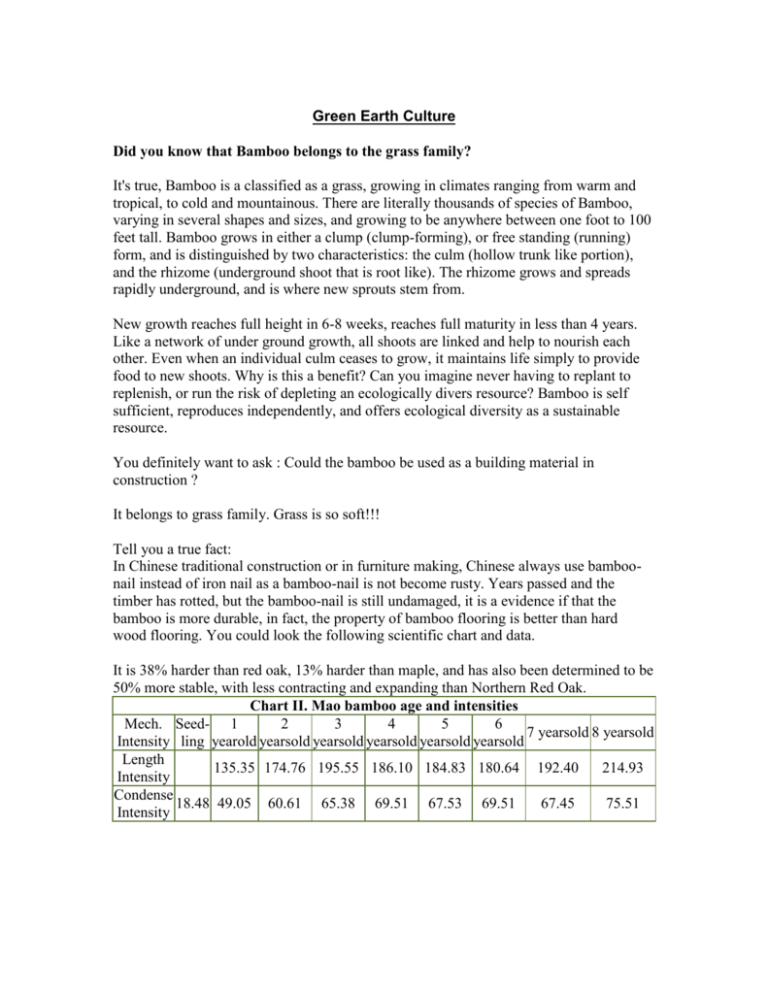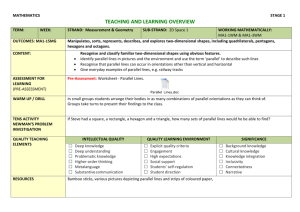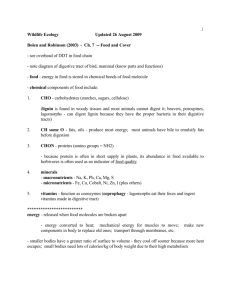Did you know that Bamboo belongs to the grass family
advertisement

Green Earth Culture Did you know that Bamboo belongs to the grass family? It's true, Bamboo is a classified as a grass, growing in climates ranging from warm and tropical, to cold and mountainous. There are literally thousands of species of Bamboo, varying in several shapes and sizes, and growing to be anywhere between one foot to 100 feet tall. Bamboo grows in either a clump (clump-forming), or free standing (running) form, and is distinguished by two characteristics: the culm (hollow trunk like portion), and the rhizome (underground shoot that is root like). The rhizome grows and spreads rapidly underground, and is where new sprouts stem from. New growth reaches full height in 6-8 weeks, reaches full maturity in less than 4 years. Like a network of under ground growth, all shoots are linked and help to nourish each other. Even when an individual culm ceases to grow, it maintains life simply to provide food to new shoots. Why is this a benefit? Can you imagine never having to replant to replenish, or run the risk of depleting an ecologically divers resource? Bamboo is self sufficient, reproduces independently, and offers ecological diversity as a sustainable resource. You definitely want to ask : Could the bamboo be used as a building material in construction ? It belongs to grass family. Grass is so soft!!! Tell you a true fact: In Chinese traditional construction or in furniture making, Chinese always use bamboonail instead of iron nail as a bamboo-nail is not become rusty. Years passed and the timber has rotted, but the bamboo-nail is still undamaged, it is a evidence if that the bamboo is more durable, in fact, the property of bamboo flooring is better than hard wood flooring. You could look the following scientific chart and data. It is 38% harder than red oak, 13% harder than maple, and has also been determined to be 50% more stable, with less contracting and expanding than Northern Red Oak. Chart II. Mao bamboo age and intensities Mech. Seed- 1 2 3 4 5 6 7 yearsold 8 yearsold Intensity ling yearold yearsold yearsold yearsold yearsold yearsold Length 135.35 174.76 195.55 186.10 184.83 180.64 192.40 214.93 Intensity Condense 18.48 49.05 60.61 65.38 69.51 67.53 69.51 67.45 75.51 Intensity The Real Renewable Resource Bamboo has been around for 200 million years and has proven to be a survivor in even the harshest of conditions. Following the atomic blast at Hiroshima in 1945, a grove at ground zero lived, and grew new Bamboo shoots within days. It was also reported in Japan that one species of Bamboo had grown 47.6 inches in a 24 hour period. These amazing growth figures make Bamboo the fastest growing plant on earth. To this day, these events are viewed by many as a natural phenomenon and a testament of Bamboo's will to live. IN addition, Unlike traditional hardwoods, which are harvested every 40-60 years, bamboo can be harvested every 3 to 5 years. Bamboo has been a fabric of life in many parts of the world. It is recognized as a food, building material, and has proven to be an important resource for filtering air and cleaning wastewater. WHY BAMBOO? Why Bamboo? Bamboo has a role to play. There is no one solution but amazingly, the simple bamboo plant can make a dramatic positive impact in many areas. BAMBOO IS: The fastest growing plant on this planet The fastest growing woody plant on this planet. It grows one third faster than the fastest growing tree. Some species can grow up to 1 meter per day. A critical element in the balance of oxygen / carbon dioxide in the atmosphere. Bamboo is the fastest growing canopy for the regreening of degraded areas and generates more oxygen than equivalent stand of trees. It lowers light intensity and protects against ultraviolet rays and is an atmospheric and soil purifier. A viable replacement for wood Bamboo is one of the strongest building materials. Bamboo's tensile strength is 28,000 per square inch versus 23,000 for steel. An enduring natural resource Bamboo can be selectively harvested annually. Bamboo provided the first re-greening in Hiroshima after the atomic blast in 1945. Thomas Edison successfully used a carbonized bamboo filament in his first experiment with the light bulb. Versatile with a short growth cycle There are over 1000 species of bamboo on the earth. The diversity makes bamboo adaptable to many environments. It can be harvested in 3-5 years versus 10-20 years for most softwoods. Bamboo tolerates extremes of precipitation, from 30-250 inches of annual rainfall. A critical element of the economy Bamboo and its related industries already provide income, food and housing to over 2.2 billion people worldwide. There is a 3-5 year return on investment for a new bamboo plantation. A renewable resource for agroforestry production. Bamboo is a high-yield renewable natural resource: ply bamboo is now being used for wall paneling, floor tiles; bamboo pulp, for paper making, briquettes for fuel, raw material for housing construction, and rebar for reinforced concrete beams. A natural controllable barrier The sum of stem flow rate and canopy intercept of bamboo is 25% which means that bamboo greatly reduces rain run-off, preventing massive soil erosion. It's anti-erosion properties create an effective watershed, stitching the soil together along fragile river banks, deforested areas An ancient medicine The powdered hardened secretion from bamboo is used internally to treat asthma, coughs and can be used a an aphrodisiac. Roots and leaves have also been used to treat venereal disease and cancer. Sap is said to reduce fever and ash will cure prickly heat. Current research point to bamboo's potential in a number of medicinal uses. Integrally involved in culture and the arts Bamboo is a mystical plant as a symbol of strength, flexibility, tenacity, endurance and compromise. Throughout Asia, bamboo has for centuries been integral to religions ceremonies, art, music and daily life. Among the earliest historical records, 2nd century B.C. were written on green bamboo strips strung together in a bundle with silk thread. Instruments made of bamboo create unique resonance. A food source Bamboo shoots provide nutrition for million of people worldwide. In Japan, the antioxidant properties of pulverized bamboo bark prevents bacterial growth and its used a natural food preservative. Taiwan alone consumes 80,000 tons of bamboo shoots annually constituting at $50 million industry. Q: What is the longevity of the bamboo? A: Bamboo weathers to a silvery gray without treatment when subject to sunlight. In northern latitudes this can take years. In southern latitudes, it can occur in one season. Weathering does not destroy the structural integrity. Many folks like the gray natural look. To keep the natural bamboo color, we suggest applying a clear UV resistant stain (water-proofing stain used for decks). Did you know that….? 1. There are over 1400 species of bamboo and probably many more. 2. Bamboo grows at phenomenal rates, up to a foot in a single day! 3. A mature 100’x100’ patch of clumping timber bamboo can produce enough construction materials to frame an entire house every year. 4. Certain bamboo root clumps can live for hundreds of years, providing an annual yield of materials. 5. A species of Bamboo was the first plant life to return after the atomic bombings of Japan. 6. Bamboo has one of the highest rates of photosynthesis of any plant species. 7. Certain timber bamboos have better tensile strengths than iron or steel on a strength per weight basis. 8. Bamboo is actually a specie of giant woody grass, giving new meaning to the idea of living in a grass hut. 9. Bamboo has over a thousand household and industrial uses including high quality paper. 10. Bamboo enriches soil with beneficial microorganisms. 11. Bamboo retains soil and lives on even after harvesting the culm or stems. 12. Bamboo is a nutritious food source for both humans and animals. 13. Appropriate, beneficial bamboos can be grown, harvested and treated right here on the Big Island with no negative impact to the soil or greater environment. 14. Bamboo is at the center of a sustainable eco-ethical industry worldwide and that new industrial applications are being developed every year. OTHER BAMBOO FACTS: ·A sixty-foot tree cut for market takes 60 years to replace. A sixty-foot bamboo cut for market takes 59 days to replace. ·Over one billion people in the world live in bamboo houses. ·The world trade in bamboo and rattan is currently estimated at 14 billion US dollars every year. Bamboos are giant, woody grasses which put out several full length, full diameter, naturally pre-finished, ready-to-use culms ("stems") each year. ·A single bamboo clump can produce up to 15 kilometers of usable pole (up to 30 cm in diameter) in its lifetime. Described as the 'wood of the poor' (India), 'friend of the people' (China) and 'brother' (Vietnam), bamboo is a wonder plant that grows over wide areas of Africa, Asia, the Caribbean and Latin America. Millions of people depend on this plant for their livelihood. ·The existence of a Bamboo Age has not been ruled out. ·Its use in food and cooking goes far back in history. Bamboo's potential for checking soil erosion and for road embankment stabilization are now becoming known. It is equally important for providing fast vegetative cover to deforested areas. Bamboo's role in the construction field is equally substantial. Hundreds of millions of people live in houses made from bamboo. In Bangladesh, 73% of the population live in bamboo houses. It provides pillars, walls, window frames, rafters, room separators, ceilings and roofs. Uses of Bamboo :There are about 1,500 documented traditional uses - from cradle to coffin - for bamboo. A few of these are: Household aphrodisiac - ashtrays - bagpipes - barrels - baskets - beds - bikes - blinds - bookcases bowls - boxes - briefcases - brushes buttons - candlesticks - crutches - desks - dolls - egg cups - fans - fences – fire starters - firewood - flutes, drums, xylophones and other musical instruments - flooring - flowerpots - frames - furniture - garments - gates - grain storage - hairpins - handles - hats - hookahs - incense sticks - jars - kites - knives laquerware - ladders - ladles - lamps & shades - landscaping - matting - mattresses medicines - napkin rings - organ pipes - ornaments - paper cutters - pegs - polo balls rattles - rings - ritual objects - skewers - splints - tea whisks - toys - toothpicks - torches trays - trellises - umbrellas - walking sticks - water storage – whistles - wine storage winnowing trays Industry activated charcoal - acupuncture needles - aircraft parts - alcohol - beer - dowel pins fireworks - light-bulb filament - looms - paper pulp - rayon - silk cocoon trays - weaving shuttles Transportation boat hoods - boats - bridges - cables - carrying poles - carts - caulking - dirigible - junks rafts - wagons - wagon floors - wheelbarrow Fisheries baskets - masts - floats - nets - outriggers - fishnets - fishing poles - sails - traps Agriculture baskets - dams - dikes - farm implements - food - forage - grain - hummers - irrigation pipes - props – sluice gates - stakes - windbreak barriers - windmills Construction hen houses - houses - plybamboo - posts - reinforcements - roofing - ropes - scaffolding screens - shingles - stilts - temporary shelters - towers – flagpoles… Construction by Green Earth Culture Resorts, Restaurants, Spas, Bridges, Cottages, Pavilions, Gazebos, Day Beds, Pathway Lamps. For information please do contact Green Earth Culture - 9422071781, 9765410717.







